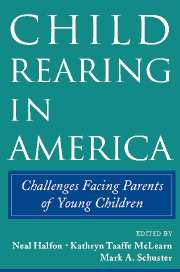Book contents
- Frontmatter
- Contents
- Tables
- Figures
- Contributors
- Acknowledgments
- 1 Introduction and Overview
- PART I CONDITIONS OF FAMILIES WITH YOUNG CHILDREN
- 2 Resources Devoted to Child Development by Families and Society
- 3 Preparing for Parenthood: Who's Ready, Who's Not?
- PART II CHILD-REARING PRACTICES
- PART III DELIVERY OF HEALTH SERVICES TO MOTHERS AND CHILDREN
- PART IV FUTURE DIRECTIONS AND POLICY IMPLICATIONS
- Index
- References
3 - Preparing for Parenthood: Who's Ready, Who's Not?
Published online by Cambridge University Press: 15 July 2009
- Frontmatter
- Contents
- Tables
- Figures
- Contributors
- Acknowledgments
- 1 Introduction and Overview
- PART I CONDITIONS OF FAMILIES WITH YOUNG CHILDREN
- 2 Resources Devoted to Child Development by Families and Society
- 3 Preparing for Parenthood: Who's Ready, Who's Not?
- PART II CHILD-REARING PRACTICES
- PART III DELIVERY OF HEALTH SERVICES TO MOTHERS AND CHILDREN
- PART IV FUTURE DIRECTIONS AND POLICY IMPLICATIONS
- Index
- References
Summary
The birth of a child, especially the first child, represents a major life transition for most parents. Parents' ability to cope successfully with their new responsibilities has lasting consequences not only for the health and development of their new baby but also for their own well-being and relationship with one another. Despite the predictability of these new challenges, adults enter parenthood with different levels of skill and knowledge and with different social and psychological resources.
To explore levels of “readiness” that new parents bring to their role, we examined data from the 1996 Commonwealth Fund Survey of Families with Young Children in four areas: whether or not the pregnancy was intended, parents' receipt of formal instruction about childbirth or parenting, parents' access to social support from family or friends, and the extent to which parents are prepared psychologically for the challenges of parenting. Our analysis addresses two basic questions: What proportion of new parents are ready for their new role in each of these domains and What risk factors are associated with being unprepared for parenthood? Although other researchers have examined these indicators separately, this study is the first to consider them concurrently using a nationally representative data set.
Overall, the results are encouraging. The vast majority of new parents appear to be prepared for their responsibilities. Over 95 percent say their child was wanted, over 75 percent attended a parenting class, and 70percent have friends or relatives to call on in an emergency.
- Type
- Chapter
- Information
- Child Rearing in AmericaChallenges Facing Parents with Young Children, pp. 50 - 80Publisher: Cambridge University PressPrint publication year: 2002
References
- 3
- Cited by



